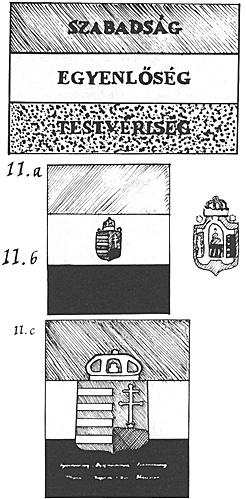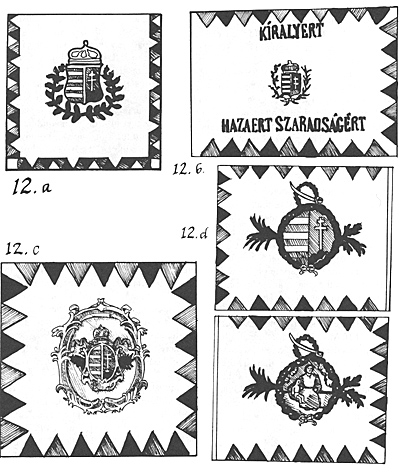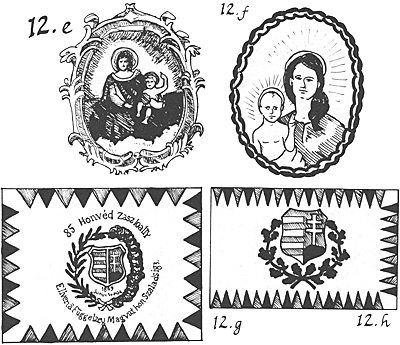There was a great variety in Hungarian battle flags during the war. All of them are unique, and gorgeous. Unfortunately only a few can be shown, but most all battle flags followed one of the designs illustrated or a combination between them.
The staff was almost always striped in a spiral design, either red or green paired stripes on white, or just green on white. Most all Honved infantry battalions carried two flags, one of which would be a standard using the national design and the other usually their first National Guard or early volunteer flag following the early revolutionary styles. A regular infantry battalion would often keep their original Austrian eagle flag. Most all had spear-points on the staffs with "HV" in the center (for Honved) and attached at the top would be several ribbons in the national colors with battle honors or slogans on them as shown in 8b. Almost all the flags noted here can be seen in color at: http://www.crwflags.com/fotw/flags/hu_h848.html including some actual photos of the originals.
In all of the illustrations, black represents green and hash-marked areas are red, except for 11 a because of the lettering and the light blue background of the center device in 12c.
 11. Hungarian Battle Flags--Early Revolutionary Flags
11. Hungarian Battle Flags--Early Revolutionary Flags
11 a. One of the first commonly used standards at the beginning of the war had red horizontal stripe over white and then green, which was modeled on the three-color flags raised by many European revolutionaries in 1848. These colors had long been part of the flag of the Hungarian Kingdom. Any number of pictures, patriotic words, or names of historic events, unit names, cities, and provinces were written on the flags. The words shown, Szabadsag, Egyenloseg, Festveniseg translates as' Liberty, Equality, Fraternity.' These tri-striped banners were carried throughout the war. A flag identical to the one shown was carried by the 39th New York during the American Civil War.
11 b. This is a typical flag of the early Honved units. The Tolna Mounted Home Guard carried the one shown. It has a red upper horizontal stripe and green lower stripe. On one side is the Hungarian coat-of-arms and the other the coat-of-arms of Tolna County, seen at the left. The Hungarian shield is red with white stripes on the left and a white cross on the right. The cross sits on a green hill. The crown and shield border is gold. The Tolna County shield is gold with a red and white Hungarian shield in the right panel, a blue-clad figure in a brown field on the left. The center has a red-clad female figure sitting on brown and gold columns.
11c. This is a flag of the Viennese Legion. The words in the lower green stripe are in gold. The first line reads' Szabadsag, Egyenloseg, Festveniseg' and the second line reads: 'Wiener Legion fair ungarn.' This refers to one unit of the Viennese Legion, the Becsi-Weiner Legion, but because there were several units by that name, which one is not clear. The Russians seized the flag at Vilagos at the end of the war. The shield in the tri-colored field is red and white, with a lighter green hill for the cross. The crown at the base of the cross is gold. The crown is also gold.
 12. Hungarian Battle Flags--National Design
12. Hungarian Battle Flags--National Design
12a. This flag was raised by the National Guard of Torda County and the design continued to be used by the 11th Szekely battalion and thel5th Mathyas [King Mathias] Hussars.
The border flames are red and green alternating on a white field. The shield is bordered in gold, inside the right half is red with a white St. Stephens cross on a green hill, while the left has alternating red and white stripes. The crown is gold. Green leaves surround the shield. On one side is the Hungarian coat-of-arms, with the arms of Torda County on the reverse, with typical county coat-of-arms, a brown castle flying red flags with green earth, blue sky in a gold shield.
12b. This is the flag of the Komaron Home Guard, another unit that kept its flag after being reorganized as a regular Honved battalion. The national design is followed as in 12a, but the central shield is smaller and the gold lettering dominates the white field.
12c. This is a typical battle flag until the April 1849 Declaration of Independence. It is an infantry standard measuring the regulation 148 cm X 165cm. It flew on a staff 312cm long, which was painted with red, green stripes in a spiral design on a white staff. The standard was white with border 'flames' alternating green and red. The coat-of-arms in the middle was red and white framed in gold, in a field of light blue. The crown of the kingdom was gold with ribbons of red, white and green below it. In the shield/coat-of-arms, the cross sits on a hill of green. The olive or oak leaves are also green. If the border looks uneven, that is because it was not symmetrical on the original.
12d. This is a cavalry standard, but was also carried by General Bern's personal staff. It has green borders all around the central shield with a gold bow at the bottom, and a gold and silver saber on the top. On one side in the circle is the red, white and green Hungarian coat-of-arms, on the other the Madonna and Child. The Madonna is in blue, the Child draped in red, with a light brown lower half of the background and a light blue upper half with white clouds and gold radiance surrounding the heads of the Madonna and Child. The skin was flesh-colored.
 12e. There was a great deal of individuality among Honved standards. Some flags had different devices on the reverse as shown in 12d and I lb. A standard could have a picture of the provincial capital on one face, another the Madonna was depicted much like the Austrian white standard of the time. Some flags are shown with all green flames, while others have a number of variations on the coat of arms device in the center. The Madonna design shown in 12e would be on one side in place of the Hungarian arms for the flag in 12c. The blue-clad Madonna and redrapped Child are sitting on white and light blue clouds with gold radiance filling the upper half of the field. The same unsymmetrical gold frame surrounds the Madonna and Child.
12e. There was a great deal of individuality among Honved standards. Some flags had different devices on the reverse as shown in 12d and I lb. A standard could have a picture of the provincial capital on one face, another the Madonna was depicted much like the Austrian white standard of the time. Some flags are shown with all green flames, while others have a number of variations on the coat of arms device in the center. The Madonna design shown in 12e would be on one side in place of the Hungarian arms for the flag in 12c. The blue-clad Madonna and redrapped Child are sitting on white and light blue clouds with gold radiance filling the upper half of the field. The same unsymmetrical gold frame surrounds the Madonna and Child.
12f. Most of the Madonna-ic flags were prepared in O'buda. Tradition holds that Jozsef Knopp was the standard painter of most "Madonna-ic" flags. They were considered 'regulation' standards along with flags that had the Hungarian shield appearing on both sides of the flag. The 12f portrait of the Madonna and Child have them clothed in the same colors as in 12e. The Madonna's hair is brown and a gold radiance surrounds their heads, but is framed by light blue at the top. The frame is also shadowed gold (dark and light gold). This Madonna and Child device is shown on a flag in a painting of the storming the Buda Fortress in April of 1849. The flag is the tri-color design and dimensions of 11 a. Instead of words, the Madonna and Child shield fills in most of the center of the flag, with about four inches from the flag edge showing above and below the shield.
12g. Many standards had the battalion's name and battle honors across the white field in black, gold, or green lettering as shown. Some of the flags have the green and red triangles meeting sides at the corners of the flag, while others have no triangles there as shown. This is the battle flag of the 85th Honved Battalion. Formed from the Szekely Grenz regiments and the Szekelyfold Volunteers later in the war, the design and colors follow regulations, but even then includes some unique features, including the words and shield decorations. The lettering is black and the leaves around the typical Hungarian shield are green. The shield is outlined in gold.
12h. This depicts the "Kossuth" flag, flown after April of 1849 as the official Hungarian battle flag. Like 12g, there is no crown above the coat of arms, demonstrating Hungary's independence from the King and Austria. Lajos Kossuth in reportedly created the Hungarian coat-of-arms in 1848, but there were many variations of it during the war. The boarder flames are red and green. The coat-of-arms is red and white with the surrounding oak leaves green. There is no gold on the borders of the shield, just a black line.
More Hungarian War of Independence 1848-1849
-
Introduction
The Hungarian Revolution
Army Organization: Austrian Imperial
Army Organization: Honved
Army Organization: Russian
Hungarian Army 1848-49: Uniforms
Hungarian Army 1848-49: Battle Flags
Hungarian Army 1848-49: Figure Availability
References
Back to MWAN # 120 Table of Contents
Back to MWAN List of Issues
Back to MagWeb Magazine List
© Copyright 2002 Hal Thinglum
This article appears in MagWeb (Magazine Web) on the Internet World Wide Web.
Other military history articles and gaming articles are available at http://www.magweb.com